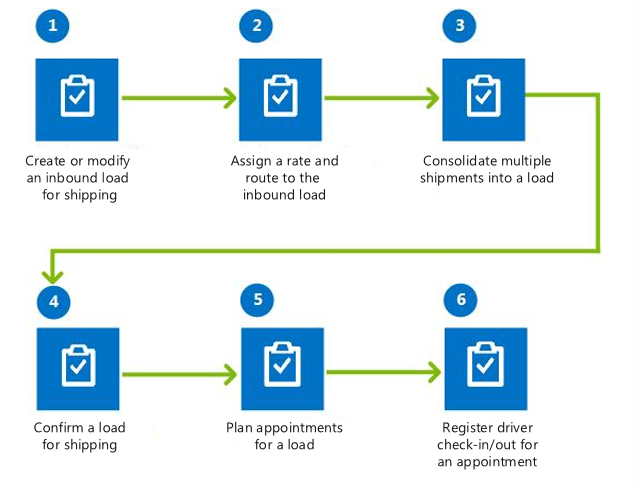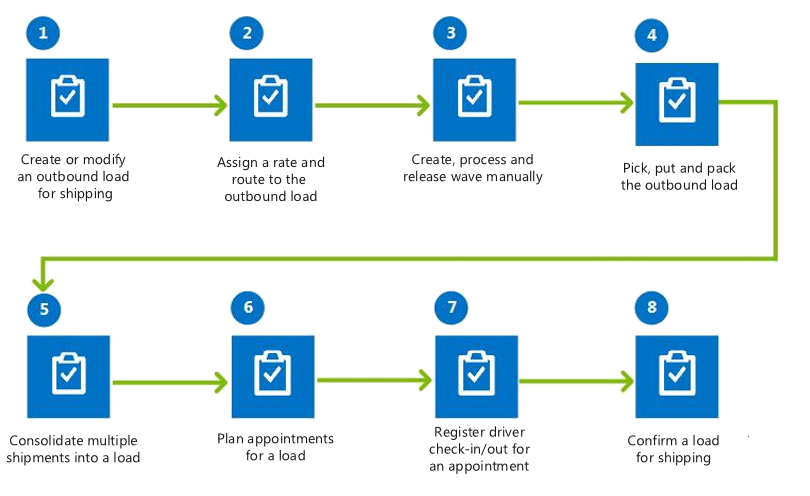Introduction
Transportation management lets you use your company's transportation and helps you identify vendor and routing solutions for inbound and outbound orders.
For example, you can identify the fastest route or the least expensive rate for a shipment.
A transportation tariff is a system of pricing, rates, and discounts that are typically defined by contracts between a carrier and its customers.
The tariffs define how much will be paid for a specific transport. In the United States, the Department of Transportation (DOT) requires interstate movers to make their rates and charges public in a tariff that details the services provided, the conditions under which the services are provided, and the prices that are charged. Each moving company determines its own rates and charges and publishes its own tariff.
To be able to use transportation management activities on a warehouse, you must consider them when setting up a warehouse. On the Warehouse FastTab, set the Use warehouse management processes slider to Yes.
Typical transportation functionality includes:
- Analytics:
- Spend analytics
- Performance analytics
- Productivity analytics
- Billing:
- Freight invoice management
- Freight reconciliation
- Disputes
- Adjustments
- Invoice settlement
- Audit
- Execution:
- Scheduling
- Dock/yard management
- Warehouse operations
- Transport documentation
- Status tracking
- Order management:
- Transport requests/orders
- Load planning
- Load optimization
- Route planning
- Load pricing/quotes
- Transport purchase order management
- Contracting:
- Carrier recruitment
- Carrier service management
- Carrier routes management
- Carrier pricing management
- Carrier contract management
- Planning:
- Capacity planning
- Sourcing plans
The Transportation management module in Dynamics 365 Supply Chain Management is designed for companies that engage logistic service providers for the transportation of their own goods and services. It can be used in scenarios for intercompany transfers and with companies that use their own vehicles for transport. The features are not ideally suited for logistic service providers or carriers, although other features of the system might be suitable for these types of organizations.
| Scenario | How transportation management can help |
|---|---|
| Use external logistics providers for transportation activities. | Use Transportation management for inbound and/or outbound transportation. |
| The company's own fleet is available for delivery/pickup, and delivery charges are passed on to customers. | For the outbound processes, you can use Transportation management to determine the transportation charges and pass them on to customers. However, the carrier invoice reconciliation process isn't required. |
| The company's own fleet is available for delivery/pickup, but delivery charges aren't passed on to customers because product prices include transportation. | A lot of the Transportation management functionality isn't required. However, you can use Transportation management to determine the transportation rates and adjust the sales price accordingly. |
| Logistics service is provided by another legal entity in the same company. | You can use Transportation management by treating the other legal entity like any other shipping carrier. You can't automate the economic transactions between legal entities. Therefore, you must handle these transactions manually (for example, by creating a purchase order). In the legal entity that provides the logistics services, Transportation management can be used to determine transportation rates. |
Inbound transportation
When you order items from a vendor, and the items must be delivered to your warehouse, you might want to arrange the transport of the items yourself. You can plan the transportation and receipt of the inbound load. The following illustration shows the business process flow for planning transportation for an inbound load.

Outbound transportation
You can plan and process an outbound load to ship specific items from a company's warehouse to a customer. You can plan the transportation and shipping of an outbound load. The following illustration shows the business process flow for planning and processing outbound loads for shipping.
